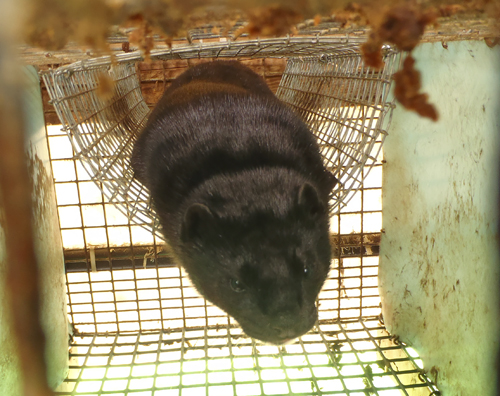
Giving mom a break is as good for mink mothers as it is for human ones. New research from animal welfare expert Georgia Mason shows that providing a respite shelf for a mink mother reduces her stress level, while her babies continue to grow well.
A professor in the Department of Animal and Poultry Science, Mason holds a Canada Research Chair in Animal Welfare. She says mink mothers show fewer signs of being stressed when they are allowed to jump onto a shelf or into a tube out of reach of their babies. Mom’s break even benefits her litter; Mason’s research found that the mortality rate for the babies was reduced. One group of mothers also had fewer signs of mastitis.
Each year, a mother mink gives birth to an average of five or six cubs. She nurses them until they are about six weeks old and well-established on solid foods. By the time they are four weeks old, the total weight of those babies exceeds the weight of the mother, and they are relentless in their demands on her.
Danish researchers were the first to suggest that shelves might be helpful. Mason, who is the only North American studying the welfare of mink raised on farms, wanted to see how it would work in a Canadian setting, and she wanted to assess outcomes for both mothers and babies.
She has found that the mothers use their escape shelves more frequently as the cubs get older, but usually for an hour a day or less in total. Mink mothers with larger litters spent more time on the shelf, but the cubs continued to grow well.
“They don’t turn into neglectful, lackadaisical mothers,” she says. In the wild, a mother mink would spend time each day foraging for food, getting short breaks from baby care.”
The mothers actually spent much less time on the shelf than Mason’s control group of female minks who did not have babies at the time. “The females without babies seemed to really like resting on the shelf and spent a lot of time there,” she says.
Mink farming is a largely unknown but significant industry in Ontario. About 123,000 mink live on some 60 farms; most of them are breeding females. When those females give birth in the spring, the population increases to almost 600,000. By comparison, that’s almost double the number of dairy cows in the province. Most of the babies will be killed for their fur at the start of winter.
According to Statistics Canada, mink raised in Ontario generate almost $40 million annually when the pelts are sold – $223 million annually across Canada.
Mason says she appreciates the willingness of mink-farm owners to open their doors and participate in the research. “Most people who work with animals believe they are doing things in the best possible way. It often takes someone from the outside to see other possibilities,” she says.
“The mink farmers were nervous at first about participating in research, but they opened their doors to us and it has paid off for them.” She says adding the shelves will lead to healthier mothers and more cubs surviving – and increased profits for the farmers.
Mason’s study was conducted over two years, with the assistance of students Lauren Dawson and Misha Buob and collaborating professor Derek Haley in the Department of Population Medicine. Mason is also studying other ways to enrich the cages that female minks spend their lives in.
The timing of her research has been fortuitous: the National Farm Animal Care Council codes are being revised this year. While these codes of practice are voluntary, they do make a difference in how animals are cared for. Mason says she expects a requirement for the addition of a shelf for the mother mink will be included in Canada’s new guidelines; Denmark has already used Mason’s research to upgrade its animal care code. “This has been very rewarding – to see that we could make such a difference with this small, simple change.”
